
HPU2. Nat. Sci. Tech. Vol 03, issue 03 (2024), 70-79.
HPU2 Journal of Sciences:
Natural Sciences and Technology
Journal homepage: https://sj.hpu2.edu.vn
Article type: Research article
Received date: 24-9-2024 ; Revised date: 04-11-2024 ; Accepted date: 11-11-2024
This is licensed under the CC BY-NC 4.0
70
On minimization of quadratic functions over closed convex sets
in Hilbert spaces
Van-Nghi Tran
a
, Nang-Tam Nguyen
b
, Chi-Thanh Le
c*
a
Hanoi Pedagogical University 2, Vinh Phuc, Vietnam
b
Duy Tan University, Da Nang, Vietnam
c
Hanoi University of Industry, Hanoi, Vietnam
Abstract
Quadratic programming problems are of primary importance in various applications and arise as
subproblems in many optimization algorithms. In this paper, we investigate quadratic programming
problems in Hilbert spaces. By utilizing the Legendre property of quadratic forms and an asymptotically
linear set with respect to a cone, we establish a sufficient condition for the existence of solutions to the
considered problems through a Frank-Wolfe type theorem. The proposed condition is based on the
special structure of Hilbert spaces, extending the applicability of quadratic programming methods.
Finally, we provide a numerical example to illustrate the results obtained and demonstrate that existing
approaches cannot be applied in certain cases.
Keywords: Quadratic program, Hilbert spaces, Legendre form, asymptotically linear, solution existence
1. Introduction
We consider the quadratic programming problems of the following form
1
min : , ,
2
s.t.
f x Qx x c x
x
(QP)
*
Corresponding author, E-mail: mr.thanh.math@gmail.com
https://doi.org/10.56764/hpu2.jos.2024.3.3.70-79

HPU2. Nat. Sci. Tech. 2024, 3(3), 70-79
https://sj.hpu2.edu.vn 71
where
is a Hilbert space, :Q
is a continuous linear self-adjoint operator, c
,
Δ
is a
nonempty closed convex set, and
,
is the scalar product on
.
In 1956, Frank and Wolfe [1] proved the solution existence theorem for a (QP) problem. This result,
called the Frank-Wolfe theorem, states that a quadratic function bounded from below over a nonempty
polyhedral convex set in
n
attains its infimum there.
Theorem 1.1 (Frank-Wolfe Theorem)
Consider the following problem
1
(QP
)
1
min : , ,
2
s.t. Δ ,
n
f x Qx x c x
x x b
1
(QP )
where
m n
A
,
m
c
and
.
m
b
If
: inf { : }
f x x
is a finite real number then the
problem has a solution.
Many authors extended/generalized the Frank-Wolfe theorem to broader classes of functions and
sets (see Blum and Oettli [2], Belousov [3], Belousov and Klatte [4], Bertsekas and Tseng [5], Semple
[6], Schochetman, Smith and Tsui [7], Borwein [8], Martínez-Legaz, Noll and Sosa [9]).
Given a quadratic function and a polyhedral convex set, verifying whether the function is bounded
from below on the set is a rather difficult task. In 1971, Eaves [10] gave a tool for dealing with the task.
Theorem 1.2 (The Eaves Theorem)
Problem
1
(QP
)
has solutions if and only if the following three conditions are satisfied:
(i)
is nonempty;
(ii) If
n
v
and
0
Av
then
, 0
Qv v
;
(iii) If
n
v
and
n
x
are such that
0
Av
,
, 0
Qv v
and
Ax b
, then
, 0
Qx c v
.
In 1999, Luo and Zhang [11] proved the important result.
Theorem 1.3
Consider the following problem
2
(QP )
1
min : , ,
2
1
s.t. : , , 0 , 1, 2,...
2
n
i i i
f x Qx x c x
x Q x x c x i m
2
(QP )
with each
n n
i
Q
being positive semidefinite,
n
i
c
and i
. Suppose that
1
Q
is positive
semidefinite and
0
i
Q
for
2,3, ,
i m
. Then, if the objective function
( )
f x
is bounded over
Δ
,
then the infimum of
2
(
QP )
is attained.
In 2000, by using the Legendre property of the quadratic form in the objective function, Bonnans and
Shapiro [12] characterized the solution existence of the problem (
QP)
with
Δ
being a polyhedral set.

HPU2. Nat. Sci. Tech. 2024, 3(3), 70-79
https://sj.hpu2.edu.vn 72
Theorem 1.4
Consider the problem
3
(QP )
1
min : , ,
2
s.t.
Δ : , , 1, 2, , .
i i
f x Qx x c x
x c x b i m
3
(QP )
Suppose that the quadratic form
Q
is a Legendre form. Then the following conditions are
equivalent:
(i) Problem
3
(
QP )
has an optimal solution,
(ii) The optimal value of
3
(
QP )
is finite.
Consider the quadratic programming problem (QP). Denote
0 1 0
1, , , { | 0}, { | 0} \
i i
I m I i I Q I i I Q I I
.
Recently, by using the Legendre property of the quadratic form in the objective function and
Condition (A), Dong and Tam [13] presented the following.
Theorem 1.5
Consider the problem
4
(
QP )
1
min : , ,
2
,
1
s.t.
Δ : , , 0 , 1, 2, , ,
2i i i
f x Qx x c x
x Q x x c x i m
4
(
QP )
where
is a Hilbert space,
,
Qx x
is a Legendre form,
i
Q
is a positive semidefinite continuous linear
self-adjoint operator on
,,i
c c
, and
i
are real number,
1, 2, ,
i m
. Suppose that
f
is
bounded from below over nonempty
Δ
and the following condition:
Condition A: If 1
I
, then
1
0 Δ, , 0 , 0
i
v Qv v c v i I
is satisfied. Then, problem
4
(
QP )
has a solution.
The purpose of this paper is to extend the results on solution existence for (
QP)
problem in
Euclidean spaces to Hilbert spaces. The idea of using the Legendre property of the quadratic form in the
objective function and weakly asymptotically linear in proving the main result.
2. Preliminaries
Let
be a real Hilbert space with a scalar product
,
and the induced norm
.
.
*
A sequence
k
x
in
is said to be converge weakly to
0
,
x
the notation
0
,
k
x x
or
0
,
w
k
x
x
if 0
, ,
k
x a x a
for each
.
a

HPU2. Nat. Sci. Tech. 2024, 3(3), 70-79
https://sj.hpu2.edu.vn 73
*
A sequence
k
x
in
is said to be converge strongly to
0
,
x
the notation
0
k
x x
, if
0
0
k
x x
.
*
A function :q
is said to be quadratic form on
if there exists a bilinear symmetric
function
,
B
on
such that
,
q x B x x
.
In this paper, we will only consider the continuous quadratic forms By Riesz Theorem [14, Theorem
2.34] it admits the following representation
,
q x Qx x
, where : Q
is a continuous linear
self-adjoint operator.
The operator : Q
is said to be positive semidefinite (positive) if the quadratic from
,
q x Qx x
is nonnegative (positive, respectively).
A function
1
, ,
2
f x Qx x c x
, where : Q
is a continuous symmetric linear
operator and c
, is called quadratic.
Definition 2.1 (see [12, p.193] or [15])
A quadratic form :q
is said to be a Legendre form if
(i) it is weakly lower semicontinuous, and
(ii)
0
k
x x
whenever
0
k
x x
and
0
k
q x q x
.
It is clear that in the case where
is of finite dimension, any quadratic form
q x
on
is a
Legendre form.
A quadratic function
1
, ,
2
f x Qx x c x
is said to be a Legendre function if
,
Qx x
is a
Legendre form.
Definition 2.2 (see [16])
Recession cone of a nonempty closed convex set Δ
is defined by
0
Δ Δ, Δ, 0 .
v x tv x t
∣
Lemma 2.1 (see [13] and [16])
If
Δ
is nonempty, then
0
Δ 0, , 0, 1, , .
i i
v Q v c v i m
∣
The following property of
0
will be used many times in our paper.
Lemma 2.2 (see [16])
Let Δ
be a nonempty closed convex set. If
Δ,
k k
x x
and
k
k
x
v
x
as
,
k
then 0
Δ
v
.
Definition 2.3 (see [17, Definition 2.3.1] for the case
n
)

HPU2. Nat. Sci. Tech. 2024, 3(3), 70-79
https://sj.hpu2.edu.vn 74
A nonempty and closed set C of
is said to be an asymptotically linear set if for each
0
and
for each sequence
k
x
satisfying
, , as ,
k
k k
k
x
x C x v k
x
there exists 0
k N
such that
0
.
k
x v C k k
Remark 2.1
Every polyhedral set is asymptotically linear (see after [17], Definition 2.3.2] for the case
),
n
but the converse is not true (see, for instance, [18]). Under the assumption that the constraint
set is asymptotically linear, the existence of solution for quadratic programming and quadratic fractional
programming has been studied in [14] and [19].
The concept of asymptotically linear sets with respect to a cone was introduced by Nghi [18].
Definition 2.4 (see [18] for the case
n
)
Let
C
be a nonempty closed and convex set and let
0
K C
be a cone. Then,
C
is said to
be asymptotically linear with respect to
K
if for each sequence
k
x C
satisfying
k
x
and
kw
k
x
v K
x
, there exists
0
such that k
x tv
, for every
0,
t
for every
k
large enough.
The class of asymptotically linear sets with respect to a cone
K
contains, in particular. The class
of asymptotically linear sets. A set
C
is asymptotically linear if and only if
C
is asymptotically linear
with respect to any
0
K C
.
We have the following lemma.
Lemma 2.3
Consider (QP) with 1
Δ : , , α 0 , 1, 2, ,
2i i i
x Q x x c x i m
, where
i
Q
is a
positive semidefinite continuous linear self-adjoint operator on
,
i
c
and
i
are real number. Let
0
Δ , 0
K v Qv v
∣. If Condition (A) is satisfied then
Δ
is an asymptotically linear set
with respect to
K
.
Proof. By a similar argument as in [20, Theorem 2.1], we obtain the desired conclusion.
3. Main result
We now consider the quadratic programming problems of the following form
1
min : , ,
2
s.t.
f x Qx x c x
x
(QP)


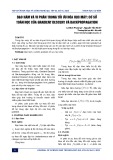
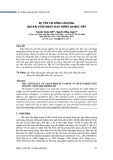
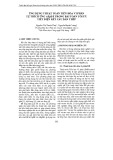
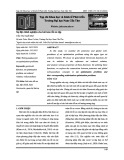
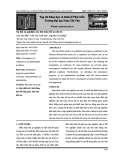

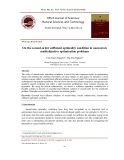
















![Quyển ghi Xác suất và Thống kê [chuẩn nhất]](https://cdn.tailieu.vn/images/document/thumbnail/2025/20251030/anh26012006/135x160/68811762164229.jpg)
